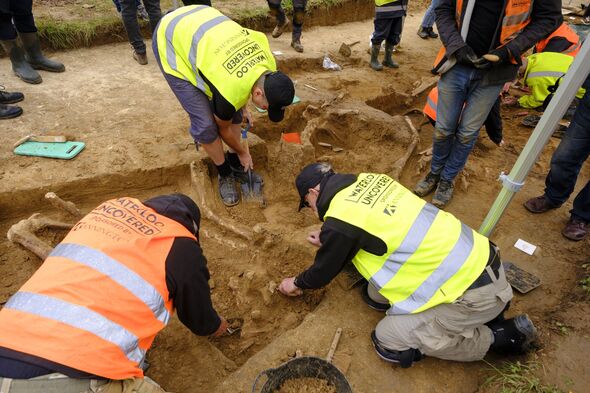A groundbreaking archaeological excavation has painted a brutal picture of what the Battle of Waterloo was really like.
The latest finding centred on a shallow ‘gore pit’ near the Duke of Wellington’s field hospital. It is thought the trench was dug to clear the hospital during and after the intense fighting.
In the shallow pit, researchers found only the second-ever full skeleton discovered after the battle. The remains were likely those of a young cavalry soldier who died from blunt force trauma to the head. The unknown soldier’s final resting position suggests that his body was carefully moved into the trench, revealing a sense of dignity that fallen soldiers were shown in the middle of the bloody battle.
Professor Tony Pollard, a historian and archaeologist at the University of Glasgow, who led the dig, said that the human remains had been separated from horses killed in the battle or put down after being wounded.
He said: “The layout of the trench, with all animal, remains on one side of the ammunition box barrier and all the human remains on the other, strongly suggests that the men who buried this individual attempted to offer him a level of dignity and respect despite the horrific scene they would have found themselves facing while clearing the field hospital of the dead.”
Researchers at the site have uncovered several other grisly remains, including 15 severed limbs, the skeletons of seven horses and one and a half cows. In 2022, three horses and a complete human skeleton were also uncovered at the same site.
More than 20,000 men were killed on June 18, 1815, during the epic 12-hour battle to halt Napoleon’s advancing forces.
The battle, led by British military officer the Duke of Wellington and a European alliance, is considered one of the bloodiest days in the history of the British Army and fundamentally changed European history.
Professor Tony Pollard, a historian and archaeologist at the University of Glasgow, explained why the latest dig was unprecedented: “On other Napoleonic battlefields, we have burial pits with humans. We have pits with horses. We even have pits with horses and humans. Nowhere else in the archaeological record do we have this combination of limbs, a burial and euthanised horses. It’s truly unique, within Napoleonic archaeology and beyond.”
The horses that the excavation uncovered included those shot to be put out of their misery.
Researchers also found evidence of brutal amputation techniques. There was evidence that surgeons did not use traditional bone saws and instead opted to disjoin limbs before pulling them clean off an injured soldier’s body. It is estimated that the war-zone surgeons carried out more than 500 amputations in one day at the field hospital without anaesthetic or antibiotics.
The excavation was led by Waterloo Uncovered, a British charity set up to support struggling veterans, who have been working on the site since 2019.
Following the grisly battle, a group of around 100 local Belgians was hired to clear the dead. These Belgians burnt and buried the bodies they found for about 10 days.
The discovery of the complete skeleton during this latest dig is rare given that many bones that were buried were later scavenged to make fertiliser for local farmers and produce refined sugar.
